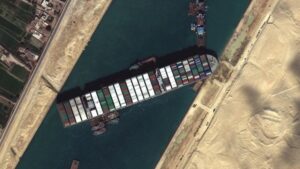 The Evergreen, a 220,000-ton mega ship nearly a quarter-mile long with a 20,000 container capacity, ran aground after being blown by strong winds while entering Egypt’s Suez Canal from the Red Sea. It’s completely blocked the passageway that is home to as much as 12% of the world’s seaborne trade and through which 50 container ships normally transit per day.
The Evergreen, a 220,000-ton mega ship nearly a quarter-mile long with a 20,000 container capacity, ran aground after being blown by strong winds while entering Egypt’s Suez Canal from the Red Sea. It’s completely blocked the passageway that is home to as much as 12% of the world’s seaborne trade and through which 50 container ships normally transit per day.
Tugboats and dredgers are currently working to dislodge the ship, which has been stuck since Tuesday evening. But the operation could take weeks, one of the executives involved has warned.
“While we believe and hope the situation will get resolved shortly, there are some risks of the ship breaking,” JPMorgan strategist Marko Kolanovic wrote in a note Thursday. “In this scenario, the canal would be blocked for an extended period of time, which could result in significant disruptions to global trade, skyrocketing shipping rates, further increase of energy commodities, and an uptick in global inflation.”
The crisis is another blow to the global supply chain after a brutal year ridden with delays, shortages and price squeezes on the back of the coronavirus pandemic.
And those delays could be more than 15 days for many ships, whose alternative is sailing around the Cape of Good Hope at the southern tip of Africa, which analysts say would increase shipping times by up to 30%.
The Evergreen’s misfortune has already impacted oil prices. News of the Suez blockage drew in buyers, and along with other economic data contributed to international benchmark Brent crude’s one-month futures contract gaining “its biggest one-day gain in nearly a year to close at $64.41” on Wednesday, according to Arctic Securities, though it lost some of those gains by Thursday.
In the meantime, between 5% and 10% of all seaborne oil is transported through the Suez, meaning that for each day that the ship remains stuck, it delays the shipment of another 3 million to 5 million barrels of oil per day. Several tankers carrying jet fuel and gasoil are also held up on the Persian Gulf-Europe route, as well as empty tankers crossing to pick up North Sea oil, S&P Platts reported Thursday.
Who is set to benefit most? JPMorgan highlights Asian liners, saying that despite higher bunker costs due to longer rerouted journeys and increased congestion, they expect higher spot freight rates. “This instead of hurting profitability is expected to be positive for bottom-line for Asia liners, in our view,” the bank wrote.
Bank of America’s analysts agree. “A Suez closure of a few weeks would be very positive for spot freight rates — by effectively removing supply by adding 20-30% to sailing distance via Cape of Good Hope,” it wrote in its note Thursday.
In the meantime, the Suez Canal’s blockage “will add to an already rising Middle East risk premium for oil and refined products,” Torbjorn Soltvedt, principal MENA analyst at Verisk Maplecroft, said, highlighting increased risk of attacks on oil facilities amid regional tensions.
Most analysts expect the situation to be cleared within the week. But “the disruption could be prolonged if there are complications or hull damage,” Bank of America wrote Thursday. When the traffic eventually gets cleared, ships will be arriving at their ports behind schedule, creating yet more congestion.
Still, the bank writes, “a blockage of a few days would be broadly manageable to the container shipping industry — perhaps involving additional fuel cost as shipping companies speed up their services to make up lost time.”
The whole fiasco underscores just how fragile the trading network that the world relies on really is, says Sutherland.
Source: “Suez Canal Blockage Could Cause Problems For The Globe”, CNBC
